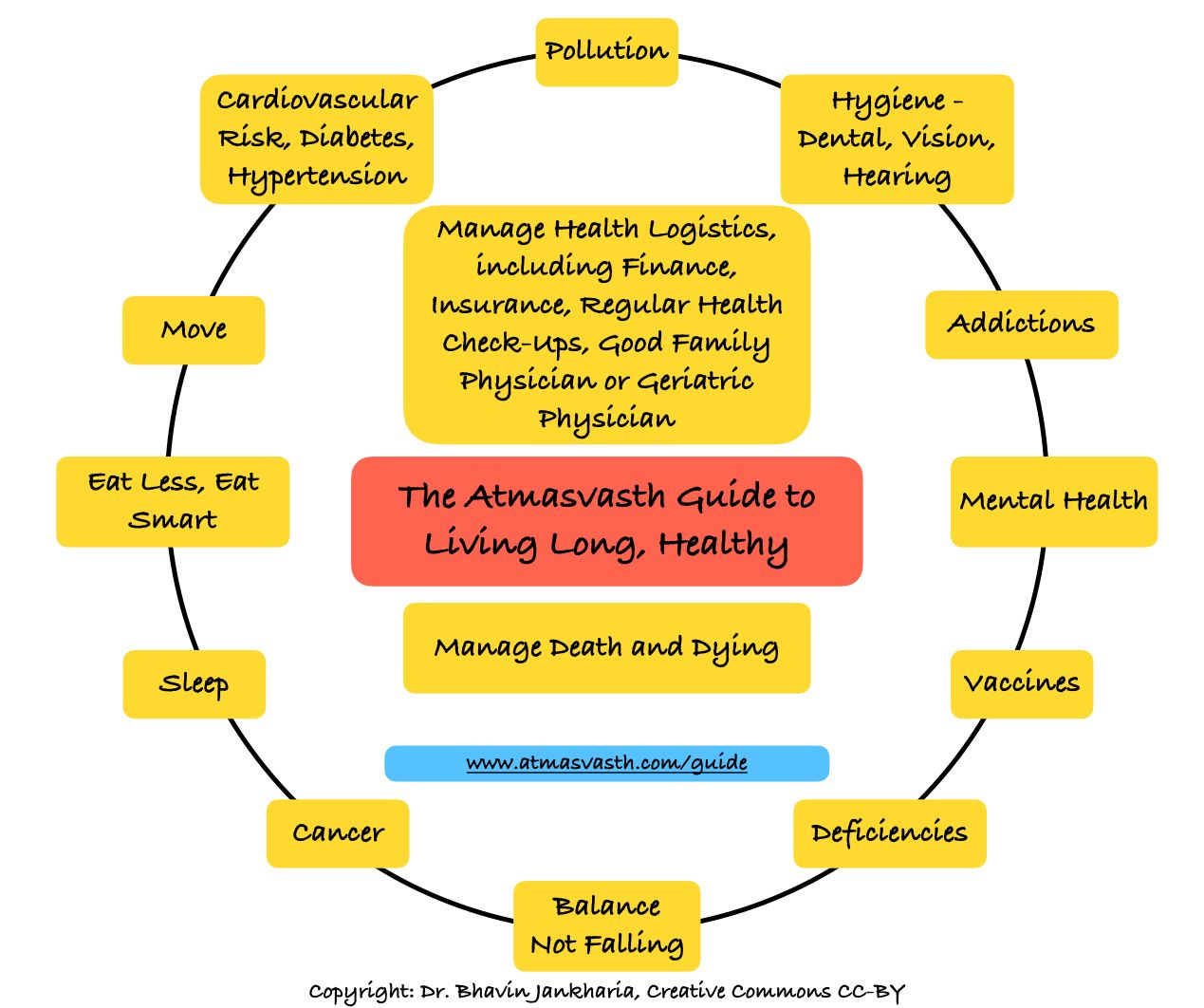Food Updates - III - Healthy Nutrition for Longevity: Deconstructing the 2024 ICMR-NIN Dietary Guidelines - Part II
The ICMR-NIN Dietary Guidelines, though patronizing, are a comprehensive set of guidelines for Indians that cover the nutritional requirements of Indians in detail

The Book - Kindle Version Now Available Worldwide

The Detailed 15-Point Guide to Live Long, Healthy

Audio
Video
The video is on YouTube.
Text
In the last post, I discussed the first four guidelines of the ten relevant ones for adults above the age of 50 years, issued recently by ICMR-NIN.
These were
1. Eat a variety of foods to ensure a balanced diet.
2. Eat plenty of vegetables and legumes.
3. Use oils/fats in moderation; choose a variety of oil seeds, nuts, nutricereals and legumes to meet daily needs of fat and essential fatty acids (EFAs).
4. Obtain good quality proteins and essential amino acids (EAA) through appropriate combination of foods and avoid protein supplements to build muscle mass.
The balance 6 are
5. Restrict salt intake.
6. Consume safe and clean foods.
7. Adopt appropriate pre-cooking and cooking methods.
8. Drink adequate quantity of water.
9. Minimize the consumption of high fat, sugar, salt (HFSS) and ultra-processed foods (UPFs).
10. Read information on food labels to make informed and healthy food choices.
5. Restrict Salt Intake
The recommendations are standard.
· Use iodized salt
· Restrict the intake of added salt (sodium chloride) to a maximum of 5g per day.
· Develop a taste for foods/diets that are low in salt from an early age.
· Restrict intake of processed and preserved foods such as snack foods, sauces, ketchup, biscuits, chips, cheese, and salted fish.
· Eat plenty of vegetables and fruits. These are good sources of potassium, which helps in excretion of sodium and helps maintain the blood pressure.
This as we know is easier said than done. I first talked about salt in Sep 2021 where I mentioned that ideally the amount of salt we consume should be less than 5 gm/day or less than 2.3 gm of sodium per day or less than a teaspoon/day. This was in reference to multiple studies that have shown that the lower the salt intake, the better is the blood pressure control. However, it is difficult to measure and control salt intake practically and so in my last piece on salt, this is what I summarized.

The only way really to control salt intake is the following
1. Reduce the consumption of UPFs.
2. Do not add extra salt to food.
3. Use a potassium enriched salt substitute (PESS).
These efforts should likely help us reduce our salt intake to between 5 and 10 gm/day and our sodium intake to between 2.3 and 4.6 gm/day.
The ICMR-NIN guidelines are inexplicably silent on the use of PESS, but this is an intervention worth considering in our effort to reduce salt intake.
6. Consume Safe and Clean Foods
These are simple guidelines, and following them makes a difference to individual and population health.
· Wash hands with soap and water before touching food, utensils or cooking.
· Buy food items from reliable sources after careful examination.
· Wash vegetables and fruits thoroughly before use.
· Wash the surface of eggs thoroughly before preserving and before preparation.
· Wash and cook meat thoroughly.
· Store raw and cooked foods separately and properly to prevent cross-contamination.
· Refrigerate perishable food items.
· Maintain good personal hygiene and keep the cooking and food storage areas clean and safe.
· Always use thoroughly cleaned utensils, knives, chopping boards.
· Consume cooked foods within 4-6 hours of preparation. If left at room temperature, reheat thoroughly before consuming.
Apart from vaccines and antibiotics, the major advances in longevity are mainly because of safe water, sanitation and hygiene (WASH) and these guidelines emphasize the importance of these basic practices in our daily lives.
7. Adopt appropriate pre-cooking and cooking methods.
These discuss the following.
· Do not wash food grains and legumes repeatedly before cooking.
· Do not wash vegetables and fruits after cutting or peeling.
· Do not soak the cut vegetables in water.
· Do not cook in excess water and discard it after cooking. Use only enough water for cooking.
· Always cover cooked foods with lids.
· Prefer pressure/steam cooking instead of deep frying/roasting.
· Consume more sprouted or fermented foods.
· Do not use baking soda while cooking pulses and vegetables as it adds to the sodium content (just like salt) of foods.
· Avoid reheating and reuse of left-over heated oils.
· Prefer earthen cookware over others.
While these guidelines make for better cooking and preservation of nutrients in vegetables, there is no real data that these allow you to live longer, healthy. Nevertheless, because these are common-sense guidelines, it is a good idea to follow them to the extent possible.
8. Drink adequate quantity of water.
The guidelines recommend drinking around 2 litres of fluid (8 glasses or so) in different combinations.
· Drink adequate quantities of safe water to meet the daily fluid requirements.
· Boil water when safety of the water is in doubt.
· Consume fresh fruits rather than in juice form.
· Prefer buttermilk, tender coconut water, lemon water, etc., as beverages in hot weather. Avoid synthetic soft drinks and carbonated beverages.
· Synthetic soft drinks are not substitutes for water and therefore should be avoided.
· Avoid alcoholic beverages.
Probably the most important takeaway is to avoid sugar-sweetened beverages, including packaged fruit juices and colas. Alcohol is not a substitute for water, though if it is consumed with adequate water or soda, then that would still take care of your water intake for the day.

The guidelines add warnings for alcohol and excess coffee and tea, which muddle this specific guideline related to water intake, so the best take here is that water in all forms is fine except for sugar-sweetened and artificial beverages and perhaps to some extent alcohol.
It is important to stay hydrated, but overhydration has its own challenges and a little sensible approach to water goes a long way.
9. Minimize the consumption of high fat, sugar, salt (HFSS) and ultra-processed foods (UPFs).
There is some repetition here from guidelines 1 and 5 and 8.
· Ultra-processed foods are usually high in fats/sugar/salt and or low in micronutrients and fibre and mostly calorie dense.
· Restrict consumption of HFSS and UPF foods: sauces, cheese, mayonnaise, jams, fruit pulps, juices, carbonated beverages, biscuits, cookies, cakes, pastries, breakfast cereals, cool drinks, health drinks, packaged fruit juices, etc.
· Always prefer fresh and minimally processed foods: whole grains such as cereals, millets, pulses and fresh vegetables, fruits, nuts and seeds.
· Even home-made foods may become unhealthy if prepared with high fat, high sugar or salt.
· Choose carefully when consuming foods prepared outside the home.
· Avoid deep fried, fatty, sugary and salty foods and bakery products.
· Food with high salt increases the risk of hypertension and burden the kidneys. Hence, it is unhealthy.
· Enriching and fortifying UPFs with nutrients does not make them wholesome or healthy
As a rule, UPFs should be avoided, but as I mentioned just two articles back, not all UPFs are bad and the classification does not take into account the complexities of food availability in today’s day and age.

10. Read information on food labels to make informed and healthy food choices.
· Nutrition and health claims are regulated by FSSAI.
· Always read food label information to know about content of foods inside a pack.
· Food label should display the name of the food, brand name, list of the ingredients, date of manufacture, use-by/expiration dates, allergen declaration, etc.
· The ingredients are presented in a descending order, with the food item that has been used in highest quantity stated as the first item.
· The nutrient content declaration is usually printed on the back of the pack. This nutrient content provides nutrients per 100gm/100ml or serve size to help the consumer make informed choices.
· Now percent RDA per nutrient for every serving of food is also mandatory on the label.
· Although nutrition and health claims are regulated by FSSAI, consumers are advised to exercise caution by cross-checking the claims with ingredients and nutrition information on the label.
This presupposes a certain level of education and understanding.
The problem with these guidelines is the fact that they are aimed at those who can read and understand and have the time, inclination and ability to go through them. When it comes to the last guideline, to actually go through, read and understand what is written on labels is a tall task even for those who are able to read and understand what is written in these labels. The number of people who can and would have the inclination to do this, is so small, that the guidelines eventually come across as patronizing, aimed at an educated upper middle class population, while discounting the practical issues of the rest of the population that will likely not ever even get to hear of the existence of these guidelines.
So what does this all mean for you and I? The ICMR-NIN guidelines are in sync with standard knowledge bases and guidelines across the world. They reiterate the consumption of a predominantly plant based diet with adequate protein intake with some control over sugar and salt, while keeping a check on the consumption of UPFs while maintaining good hygiene standards.
Footnotes
1. https://main.icmr.nic.in/sites/default/files/upload_documents/DGI_07th_May_2024_fin.pdf
Atmasvasth Newsletter
Join the newsletter to receive the latest updates in your inbox.



